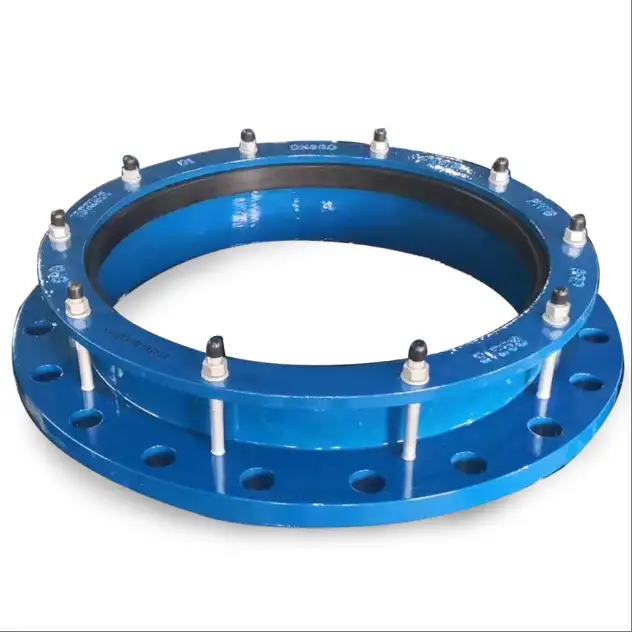Standard 10-inch (DN250) ductile iron elbows feature a center-to-face dimension of 152 mm (6″) for 90-degree elbows and 76 mm (3″) for 45-degree elbows, conforming to ANSI/AWWA C110/A21.10 standards. These pressure-rated fittings maintain consistent 10.75″ OD (273 mm) pipe connections with 5/8″ (16 mm) bolt holes for flange attachments. Key specifications include 250 psi maximum working pressure, 0.25″ (6.35 mm) minimum wall thickness, and 18.5°-22.5° bevel ends for seamless welding.

1. Industry Standards Governing 10-Inch Ductile Iron Elbows
Ductile iron elbows are manufactured in compliance with various industry standards to ensure quality, compatibility, and safety. Key standards include:
-
ANSI/AWWA C110/A21.10: Covers ductile iron and gray iron fittings with flanged ends, specifying dimensions and tolerances.
-
ASME B16.42: Specifies dimensions for ductile iron fittings for pressure applications, including flanged fittings.
-
ASTM A536: Defines the standard specification for ductile iron castings, detailing mechanical properties.
These standards ensure that 10-inch ductile iron elbows meet specific requirements for pressure ratings, dimensions, and material properties, facilitating interoperability and safety in piping systems.
2. Dimensional Specifications of 10-Inch Ductile Iron Elbows
Understanding the precise dimensions of 10-inch ductile iron elbows is crucial for system compatibility and performance. Key dimensions include:
-
Radius (R): The centerline radius of the elbow, typically 9 inches for a 90° elbow.
-
Face-to-Face (A): The distance between the two flanged ends, commonly 11 inches for a 90° elbow.
-
Weight: Approximately 165 pounds for a standard 90° elbow.
These dimensions may vary slightly depending on the manufacturer and specific design requirements.
3. Material Properties and Coatings
Ductile iron is favored for its strength, durability, and resistance to corrosion. Key material properties include:
-
Tensile Strength: Typically around 65,000 psi, providing excellent structural integrity.
-
Yield Strength: Approximately 45,000 psi, ensuring resilience under pressure.
-
Elongation: Around 10%, indicating good ductility.
Coatings such as epoxy or bituminous coatings are often applied to enhance corrosion resistance, especially in aggressive environments.
4. Applications and Installation Considerations
10-inch ductile iron elbows are utilized across various industries, including:
-
Water Distribution Systems: Providing reliable directional changes in municipal water networks.
-
Wastewater Treatment Plants: Handling corrosive and abrasive fluids in treatment processes.
-
Industrial Piping Systems: Facilitating the transport of various industrial fluids under pressure.
Proper installation practices are crucial for ensuring the effectiveness of these components. Key considerations include:
-
Alignment: Ensuring that elbows are properly aligned to prevent undue stress and potential leaks.
-
Bolt Torque: Applying the correct torque to bolts to achieve a uniform seal without damaging components.
-
Gasket Selection: Choosing appropriate gasket materials compatible with the conveyed fluid and operating conditions.
Adhering to best practices during installation helps maintain the integrity and performance of the piping system.
5. Comparative Analysis of 10-Inch Ductile Iron Elbow Dimensions
The following table provides a comparative analysis of 10-inch ductile iron elbow dimensions based on different standards:
| Standard | Radius (R) | Face-to-Face (A) | Weight (lbs) |
|---|---|---|---|
| ANSI/AWWA C110 | 9.00 in | 11.00 in | 165 |
| ASME B16.42 | 10.88 in | 14.50 in | 172 |
| ISO 2531 PN10 | 260 mm | 190 mm | 46.5 kg |
This comparison highlights the variations in dimensions based on different standards, emphasizing the importance of selecting the appropriate standard for specific applications.
6. Frequently Asked Questions (FAQs)
Q1: What is the significance of the radius in a 10-inch ductile iron elbow?
A1: The radius of a ductile iron elbow determines the curvature of the bend, affecting flow characteristics and space requirements. A standard radius provides a balance between efficient flow and compact design, while a long radius offers smoother flow with reduced pressure loss but requires more space.
Q2: How do I ensure compatibility between ductile iron elbows and other piping components?
A2: Compatibility is ensured by adhering to the same industry standards across all components, such as ANSI/AWWA C110 or ASME B16.42. Additionally, matching pressure ratings, flange dimensions, and material properties is crucial for a secure and efficient piping system.
Q3: What are the common coatings applied to ductile iron elbows, and why are they important?
A3: Common coatings include epoxy and bituminous coatings, which provide corrosion resistance and extend the lifespan of the fittings. These coatings are particularly important in environments with aggressive fluids or external conditions that may lead to corrosion.
References:
ASTM A536 – Standard Specification for Ductile Iron Castings (ASTM International)
